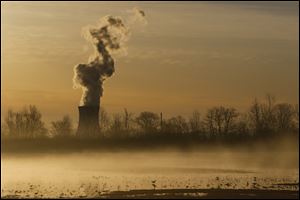
Regulatory commissions take interest in FirstEnergy bankruptcy
6/7/2018Though not mentioning it by name, the governing boards of the U.S. Nuclear Regulatory Commission and the Federal Energy Regulatory Commission obviously have taken a keen interest in the recent bankruptcy filing by two FirstEnergy Corp. subsidiaries and what it could mean to the nation’s energy future.

FirstEnergy Corp.'s Davis-Besse Nuclear Power Station in Oak Harbor.
During the first joint meeting of those boards in nearly 16 months, NRC and FERC leaders were briefed Thursday on anything from grid reliability to protection from cyber attacks. But high-profile economic struggles facing the nuclear industry factored into that discussion out in Washington, too, with NRC leadership defending itself from claims that it may have helped accelerate the industry’s decline with regulations that some pro-nuclear advocates believe has been too onerous.
“We are not economic regulators. We are safety regulators,” NRC Chairman Kristine Svinicki told FERC board members.
Both agencies had gone through extended board vacancies since 2014, but now have all commissioner seats filled.
Although NRC officials said they believe their agency’s commitment to safety has always been appropriate, they also acknowledged they continue to remain open-minded to streamlining more rules, doing inspections more efficiently, and, consequently, being less burdensome on industry as long as the same level of protection can be provided.
But Ms. Svinicki said she is convinced nothing could have saved certain plants even if the NRC had “radically” changed the way it regulates long before electricity markets in several parts of the country, including Ohio and Pennsylvania, were upended by record-low natural gas prices following historic developments in shale-fracturing techniques over the past decade.
“I don’t know what could have been done,” she said.
The discussion came up after one of FERC’s commissioners, Robert F. Powelson, a former chairman of the Pennsylvania Public Utility Commission, noted the economic struggles of America’s current 99 nuclear plants and the reluctance of utilities to invest in a next-generation fleet just as large as today’s commercial-scale behemoths to replace them.
The industry now appears to be moving toward the development of scaled-down versions known as small modular reactors, but even their future isn’t guaranteed.
Mr. Powelson told NRC board members that America’s experience with nuclear power is “not a national success story in terms of costs.”
Mr. Powelson, who was nominated to FERC’s board of commissioners 13 months ago and confirmed by the U.S. Senate last August, said plants built mostly in the 1970s and 1980s are “operating on razor-thin margins” today, and said an unnamed utility has told him NRC regulations are forcing nuclear plants out of business.
It’s far more complicated than that, NRC officials assured him.
Six reactors have closed over the past five years from either economic or mechanical issues, the largest batch of closures in any half-decade. Several more are in danger of premature closures, including Davis-Besse east of Toledo, Perry east of Cleveland, and the twin-reactor Beaver Valley nuclear complex west of Pittsburgh.
Each of those is owned by FirstEnergy Solutions, a subsidiary of Akron-based FirstEnergy Corp. FES filed for bankruptcy in March along with FirstEnergy Nuclear Operating Co.
Last Friday, after being courted for months, the Trump Administration announced it has directed U.S. Energy Secretary Rick Perry to develop a lifeline for both the struggling nuclear and coal-fired power industries by requiring regional grid operators to continue buying electricity from them — even at above-market rates — as a matter of national security.
Critics have claimed that’s illegal and an abuse of two federal laws they assert are reserved for times of war and natural disasters. Mr. Perry told journalists this week he has only received the directive, and is in the early stages of writing it.
Barring a buyer or bailout, FirstEnergy Solutions plans to close Davis-Besse by May 31, 2020, and the other three reactors before Oct. 31, 2021.
Another FERC commissioner, Neil Chatterjee, asked under what scenario the NRC might allow a mothballed nuclear plant to be put back into service if — at some point after closure — market conditions or other factors justify such a restart.
“I'm particularly interested in what you see as the regulatory point of no return,” Mr. Chatterjee said.
Dan Dorman, a senior NRC official, said the agency’s position is that nuclear plants are considered to be at the end of their lives once a utility formally notifies the NRC in writing it has been closed for good. Reopening a mothballed plant would require a new operating license, he said.
“When a licensee says they have permanently ceased operation, that ends it,” he said.
He said the NRC is willing to “peel back” in any areas it finds where regulations are deemed excessive, as long as doing so doesn’t compromise safety.
Contact Tom Henry at thenry@theblade.com, 419-724-6079, or via Twitter @ecowriterohio.